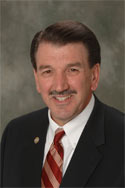By J. Larry Miller
The cold weather and frost that hit last Friday morning marks the end of the growing season and the reality that winter cannot be far away. Pastures will not be growing and the beginning of the daily task of feeding hay will soon be upon the livestock producers.
As I drive by cattle grazing on pasture, I realize that the summer has been good for cattle producers as the cows are in very good condition going into winter. Hay supplies are good so I guess so bring on the snow and cold weather!
Harvesting is still very much with us but harvested fields are out numbering those that have not yet been harvested. Wheat planting is probably complete so that all effort can be focused on harvesting. Fall fertilizer is being applied and fall application of herbicide will soon be in full swing.
Spraying in the fall for weed control is a fairly new operation added to fall work but weed control is now a year-around task.
Some of you are aware that the Franklin County Ag in the Classroom Program has, in the past, been the recipient of the Monsanto Grant. This grant has to be applied for by farmers in Franklin County who are at least 21 years of age and actively farm a minimum of 250 acres of corn, soybeans and/or cotton or 40 acres of open field vegetables. An active farmer is one who is “actively engaged in farm work, or hires and actively manages others to do so.”
The Franklin County Ag in the Classroom is a vital part of the education of children in pre-school through 8th grade in Franklin County and is in need of your support to continue with this education.
It is very easy to apply for the Monsanto Grant – simply sign-up online at www.growcommunities.com and fill out the short form. This form will ask for your name, address, phone number and email address along with the entity that you would like to receive the grant. In the space provided please type in Franklin County Ag in the Classroom. If you would rather take the time to make a phone call you can do so by calling 877/267-3332. Grant applications are due by November 15th.
If you have any questions please call Gay Bowlin at the Franklin County Farm Bureau at 435-3616.
I want to remind everyone that the Franklin County Farm Bureau is taking orders for fruit and pecans again this year. Call the office to place your order now.
Remember to call now to make your reservation for the Franklin County Farm Bureau Annual Meeting on December 2nd at the Benton Civic Center.
Remember we are farmers working together. If we can help let us know.



